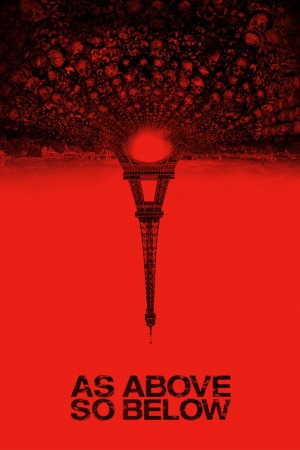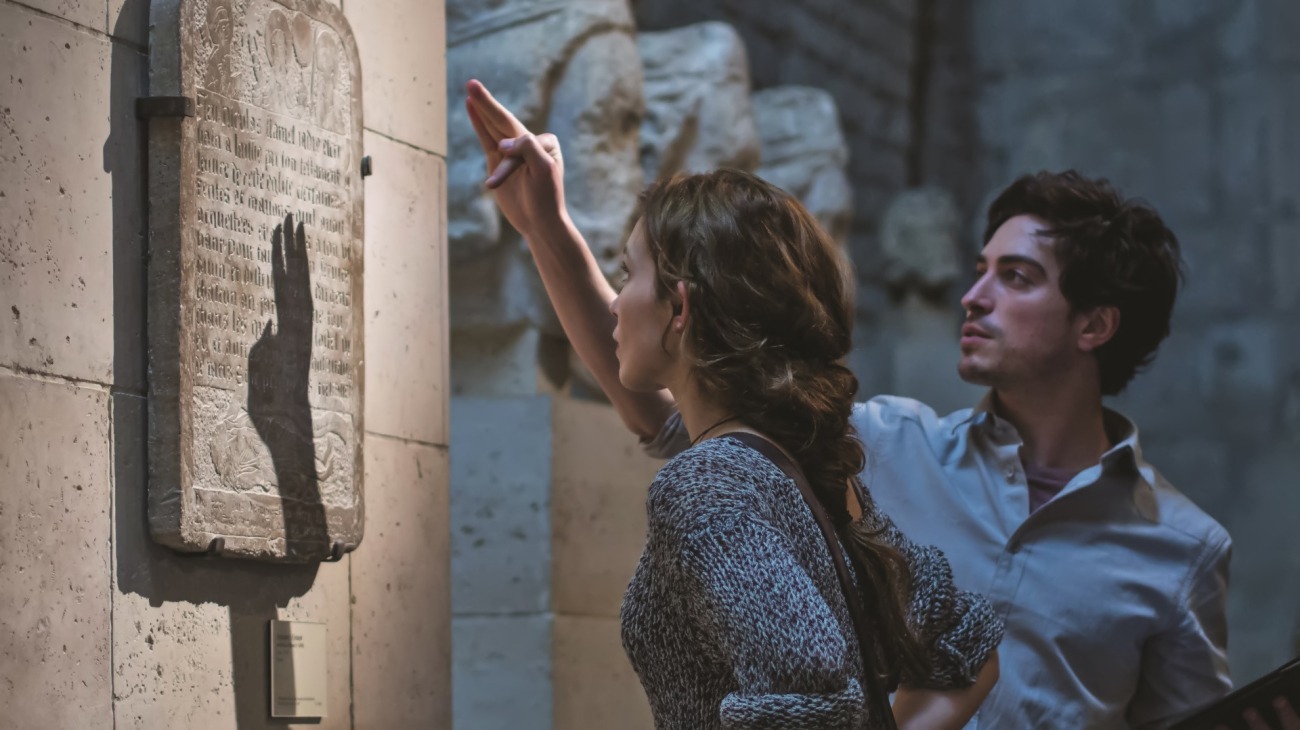
Under the streets of Paris
There's no piece of crap quite as infuriating as a piece of crap that had absolutely no right to be so crappy, and as evidence I offer As Above, So Below, a film that manages to squander what should be a completely un-fuck-up-able location even in the hands of the most fumbling boob. In part, this is because of its totally pointless insistence on presenting its action in the form of found footage, and then immediately finding every possible mechanism it can to avoid the limitations of that style by equipping the entire cast with tiny cameras, so that most of the action can be presented in the form of totally unexceptional continuity editing. The other part is that the film's screenplay feels like it happened because the writers, brothers John Erick (who also directs) and Drew Dowdle, couldn't decide between ripping off The Da Vinci Code, the first two Harry Potter books, Indiana Jones and the Last Crusade, The Descent, The Divine Comedy, and Tomb Raider, and so they decided to go ahead and do all of them at once, and just for funsies, to mortar the dismal construct that resulted together with some insulting half-baked nonsense about people fighting their inner demons in what may or may not be the actual, literal Hell.
The movie's inner confusions start off early, and they start off strong, with a prologue set in Iran, where British-ish Wunderkind Scarlett Marlowe (Perdita Weeks) - who speaks seven languages and has two PhDs, and has the polished but impersonal good looks of an underwear model on top of it, all without having apparently attained the age of 30 - is hunting through a cave system that the government is about to blow up, looking for Proof. The Proof comes in the form of a giant carving of some Mespotamian animal god with carvings all over it; cautiously making sure to film all of this for later reference, she sneaks out just as the bombs start exploding, and gives us the first of many experiences we'll have with some of the most nauseating shakycam I have experienced in many a day.
The carvings turn out to be the key to translating a code used by medieval European alchemists, but as Scarlett happily tells Benji (Edwin Hodge), who is filming a documentary on her work, conveniently enough, it will translate that code into Aramaic, one of the only languages she doesn't speak. Luckily, she knows someone who does: her ex-maybe-a-boyfriend?-it's-deliberately-not-clear George (Ben Feldman, who looks even more like an underwear model than Weeks), currently in Paris breaking into old cathedrals and fixing their ancient clock towers, because that's both edgyhip and artistically sensitive all at one time. He is eager to help her translate the cryptic inscription on the tomb of French alchemist Nicolas Flamel, who supposedly discovered the secret to creating the philosopher's stone before his death in the 15th Century. And while the stone can convert any metal to gold and prolong life, Scarlett only wants it to prove her father's theories right, though what those theories might have been is left entirely as an exercise for the viewer.
So anyway, some puzzle-solving exercises later, Scarlett determines that she needs to go into the catacombs beneath Paris, which requires the aid of the urban spelunking team made up of Papillon (François Civil), Souxie (Marion Lambert), and Zed (Ali Marhyar), who really got the short end of the stick on the badass French nicknames. And into the ground all six go - George against his will and only to avoid the cops, where they pass by a corridor that Papillon insists they must absolutely not for any conceivable reason enter, because it is pure evil and everyone who frequents the catacombs knows it. So obviously they end up in that corridor, though to be fair, the film plants enough Chekhov's guns that never fire that it would be entirely rational to suppose that such an overt "the horror film part starts when we enter that particular cave" bit of foreshadowing wouldn't play out.
It is, I imagine, quite impossible to set a film in the Paris catacombs and completely mess up the sense of grim, suffocating atmosphere, and Dowdle and his cinematographer, Léo Hinstin, don't manage to do it. But fuck me, do they come close. Part of it is the original sin of the found-footage aesthetic: it's ugly. The shaking is ugly, the video noise is ugly, the color range is ugly. Part of it, and possibly even the bigger part, is that the film is surprisingly bright: considering that the only light is nominally the head lamps the six explorers are wearing, the film is full of suspiciously well-illuminated locations, even the ones that the narrative would appear to demand are completely drenched in inky, unknowable blackness. And so what ought to be the film's single biggest strength, its close, stuffy, inherently spooky location, falls completely apart.
That being said, As Above, So Below spends an heroic amount of its running time trying to do anything at all besides being spooky, enough so that I couldn't decide for the first hour if it even qualified as a horror film (in the first 30 minutes or so, before the action heads underground, the answer is plainly "hell no, it's a debased knock-off of The Da Vinci Code", and that's a book that already did a perfectly fine job of debasing itself, thank you). It's much more eager to dig into the minds of its characters, with its functional scare scenes coming in the form of surrealistic interludes where one character at a time is forced to deal with the deep secret trauma that they've been carrying around all this time, except that doesn't apply to fully half the cast, unless Benji has some dark past involving weird girls with Goth mascara who are apparently stalking him in what is by far the most annoying of the movie's undeveloped plot hooks. And even for the half to whom it does apply, they're such generic traumas, and they have happened in the past of such flimsy stock characters, that the film's passion about playing as psychodrama more than a simplistic "boo!' machine hardly seems worth it.
Every now and then, an image will manage to be creepy despite itself (mostly by virtue of being blatantly derivative of something better), and there's one sequence with Benji stuck in a tight crawlspace that manages to evoke the raw panic of being contained in someplace small and remote to absolutely terrific effect - the morbidly claustrophobic, I imagine, would be entirely incapable of handling the scene, and the rest of us get one of the genuinely terrifying moments I have seen in a movie this year. But scattered moments surrounded by bullshit plotting, bullshit characters, and bullshit filmmaking technique doesn't save a movie from being bullshit; there are a billion ways to fix the film (squelch the found footage angle, don't use "maybe it was hell!" as an excuse for dimwitted nonsensical third-act plotting, don't give the characters Dark Pasts if you can't come up with a good one), but only one way that such a terrific location could be wasted on such a weirdly overplotted, unfocused waste of time.
And by the way, figuring out a way to have your sole black character be the camera operator in a found-footage movie and still kill him off as one of the first victims? Way to play down to the genre's worst clichés, guys!
2/10
Categories: crimes against art, first person camera, horror, thrillers






